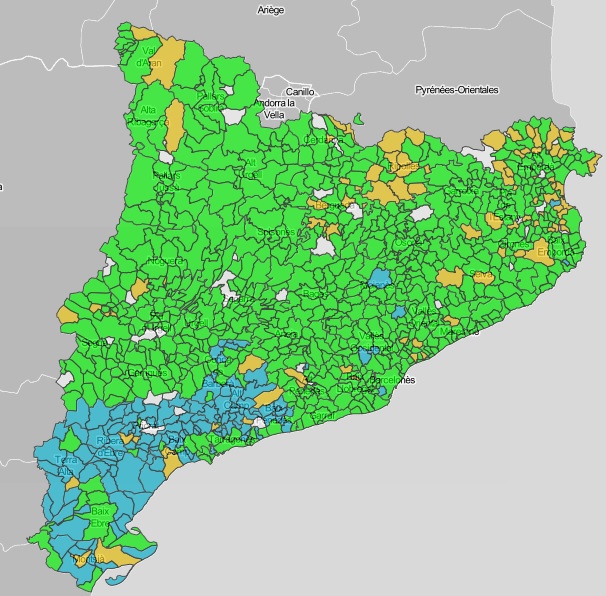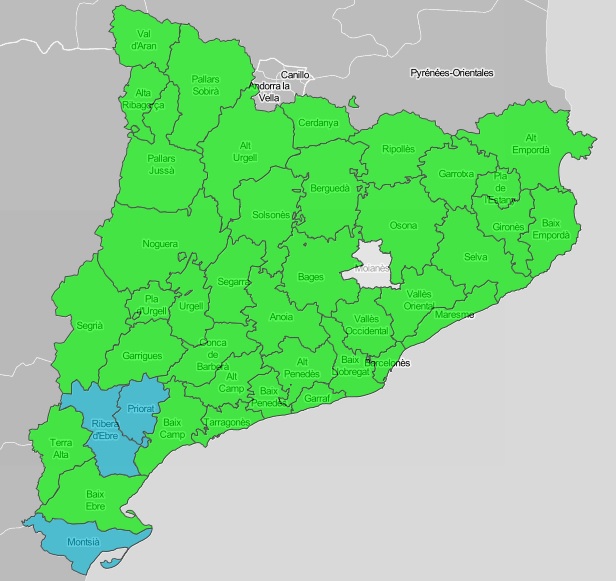Electronic Administration Indicators in Catalonia
In the framework of the development of e-government, from the AOC we understand the state of the administration with regard to the municipal instruments of e-government and, more specifically, the effective recognition of the rights of citizens as a result of the regulations governing the use of electronic media, transparency, access to public information and good governance.
To this end, we periodically carry out a review of the state of e-government in the 947 municipalities of Catalonia.1 and we publish the data in a report. Likewise, the results of the analysis are reflected in an interactive map of Catalonia.
Catalan municipal map
 Al Catalan municipal map you can access the information related to the 947 Catalan municipalities:
Al Catalan municipal map you can access the information related to the 947 Catalan municipalities:
The information shown on the maps is the most recent. If you want to know the data of the previous studies you can access the reports on administration.
Catalan regional map
You can also consult the data of the 42 county councils at e-government map by counties.
The information shown on the maps is the most recent. If you want to know the data of the previous studies you can access the reports on administration.
The reports on e-Government are the result of a study carried out by the staff of the AOC Technical Office in a specific period of time and based on:
- the monthly collection of indicators for AOC services
- the analysis of the offer and use of the services of electronic Administration.
INDICATORS ANALYZED
Below we detail the parameters analyzed in the study, grouped into six blocks
1.- Information
- If you have a citizen's folder
It is an environment of communication between the public and the citizenry. It allows you to process and make consultations in a totally confidential and secure way about the subjects of interest of the citizens (registration, taxes, etc.) without having to go to the municipal units. - If you have an electronic office (headquarters)
The e-Office is the email address available to citizens through which public administrations disseminate information and provide services. The ownership, management and administration of the electronic headquarters corresponds to a public administration, body or administrative entity in the exercise of its powers. The headquarters guarantees the unequivocal and full identification of the owner administration and the veracity, integrity, authenticity and validity of all the contents. - If you offer the contracting profile
If the city council has on its web page a space of public access to the information regarding its contractual activity. - If you provide cartographic information online
If the local authority has incorporated some type of map viewer (street, general map viewer ...) into its web page as an interactive viewer, not as a map in Word or PDF format. - If you publish the mapping of your urbanism
If the city council publishes data on the town's urban planning through an interactive map server. - If you have a search engine on your website
If the municipal website has a content search engine. - If you have an electronic board
It is the electronic means of publishing information of general interest, communications and acts issued by the local authority. As the e-headquarters, the electronic board has assured the requirements of security, integrity, authenticity, availability and evidence generation. - If you have a transparency portal
In its preamble, Law 19/2014, of December 29, on transparency, access to public information and good governance, defines it as "the basic and general instrument to provide citizens with information in an integrated way. all public administrations. This portal is configured as an electronic advertising platform on the internet, which provides access to all available information and contains links to the electronic offices of the administrations and entities that integrate with it. "
2.- Processing
- If the city council offers online procedures
If the entity has electronic procedures, based on a form that allows the citizen to start and end administrative management online, without having to go to the municipal offices. If the city council only offers the option of downloading forms (such as a Word or PDF document), we consider that it does not offer online procedures - If you have the option of processing a generic request or request online
If you offer the possibility to process a generic request or request online, understanding that this would allow you to be able to give a minimum compliance with the obligation to offer the possibility to the citizenry to interact through any means - If you send us electronic notifications
If the city council sends notifications by electronic means - If you accept the electronic invoices
If the city council has an electronic invoice receipt system
3.- Data exchange
- If the city council exchanges data with other administrations
If the entity is activated in the Interadministrative Collaboration Platform (PCI) of the AOC Consortium. Those activated on this platform can use the so-called 'inter-administrative collaboration services', which allow telematic access to data and documents held by other administrations. As a result of the work done by the AOC Consortium in collaboration with the information issuing institutions, at present the Catalan public administrations activated in the PCI can access services such as: residence data in the population register (local administration), data related to being aware of tax obligations (State Agency of Tax Administration) or verification of identity data (Directorate General of Police). - If you offer your census of inhabitants
If the city council has made the telematic connection of the data of its municipal register of inhabitants with the platform of the AOC Consortium (as a data transmitter) and, therefore, makes its data available to the other administrations . - If you offer change of address communication
If the city council, after connection of its municipal register of inhabitants to the platform of the AOC Consortium, offers citizens the possibility of telematically communicating the data of their domicile of residence (what is included in the municipal register) to other public administrations.
4.- Electronic signature
- If the city council is a T-CAT registration entity
The T-CAT registration entities are T-CAT card issuers, the staff card of the Catalan public administrations and contains CATCert recognized digital certificates that allow to guarantee the identity and personal attributes of its holder and that it is linked to the subscriber belonging to the public sector. - If the city council is an idCAT registration entity
IdCAT is a digital identifier for citizens and validated by the collaborating registration entities. It ensures the integrity and confidentiality of electronic transactions and guarantees the identity of citizens through electronic signatures
5. -Regulation
If the city council has approved regulations in the field of electronic administration
If the city council has approved any specific rule to regulate the use of electronic media in its administration (ordinance regulating electronic administration, electronic registration and electronic headquarters).
6.- Change management
- If the city council has adopted a working method to digitize its internal management (e-SET)
- If the city council has joined the service Unique Local Business Window
The result of this analysis is contrasted with the technical staff of the county councils, in accordance with the collaboration agreement that exists between the councils and the AOC Consortium.
1In the first three reports of 2010, data were collected from 946 city councils, as La Canonja was not yet legally an independent municipality. The municipality of Medinyà was also analyzed at the time until its disappearance in February 2018.
All reports
- Report 1 (January 2010) (104,27 kB)
- Report 2 (May 2010) (127,62 kB)
- Report 3 (October 2010) (126,21 kB)
- Report 4 (January 2011) (125,76 kB)
- Report 5 (April 2011) (125,02 kB)
- Report 6 (July 2011) (124,21 kB)
- Report 7 (October 2011) (121,15 kB)
- Report 8 (January 2012) (123,30 kB)
- Report 9 (April 2012) (127,25 kB)
- Report 10 (November 2012) (575,01 kB)
- Report 11 (March 2013) (573,22 kB)
- Report 12 (July 2013) (572,80 kB)
- Report 13 (February 2014) (418,40 kB)
- Report 14 (September 2014) (417 kB)
- Report 15 (May 2015) (705 kB)
- Report 16 (May 2016) (815 kB)
- Report 17 (January 2017) (506 kB)
- Report 18 (December 2017) (500 kB)
Evolution of the data of the reports on the e-Administration (December 2017) (977 kB)
NOTE: : The data collected in these reports are now published in open data format at public indicators of activity

